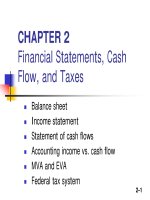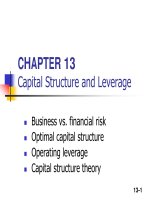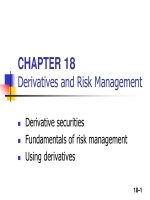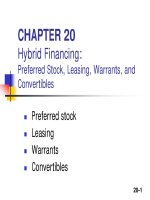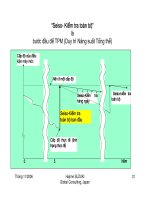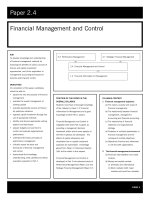International Financial Management phần 6 pptx
Bạn đang xem bản rút gọn của tài liệu. Xem và tải ngay bản đầy đủ của tài liệu tại đây (613.5 KB, 10 trang )
The exchange rates at the beginning of each of the last 16 years for each currency (with
respect to the U.S. dollar) are shown here:
The confidence intervals for each currency can be applied to the expected book revenues
to derive confidence intervals in U.S. dollars to be received from each country. Complete this
assignment for Whaler Publishing Company, and also rank the currencies in terms of
uncertainty (degree of volatility). Since the exchange rate data provided are real, the analysis
will indicate (1) how volatile currencies can be, (2) how much more volatile some currencies
are than others, and (3) how estimated revenues can be subject to a high degree of
uncertainty as a result of uncertain exchange rates. (If you use a spreadsheet to do this case,
you may want to retain it since the case in the following chapter is an extension of this case.)
CHAPTER 10 WHALER PUBLISHING COMPANY
Measuring Exposure to Exchang e Rate Risk
Recall the situation of Whaler Publishing Company from the previous chapter. Whaler
needed to develop confidence intervals of four exchange rates in order to derive confi-
dence intervals for U.S. dollar cash flows to be received from four different countries.
Each confidence interval was isolated on a particular country.
Assume that Whaler would like to estimate the range of its aggregate dollar cash flows
to be generated from other countries. A computer spreadsheet should be developed to
facilitate this exercise. Whaler plans to simulate the conversion of the expected currency
cash flows to dollars, using each of the previous years as a possible scenario (recall that
exchange rate data are provided in the original case in Chapter 9). Specifically, Whaler
BEGINNING
OF YEAR
AUSTRALIAN
$
CANADIAN
$
NEW
ZEALAND
$
BRITISH
POUND
1 $1.2571 $.9839 $1.0437 £2.0235
2 1.0864 .9908 .9500 1.7024
3 1.1414 .9137 1.0197 1.9060
4 1.1505 .8432 1.0666 2.0345
5 1.1055 .8561 .9862 2.2240
6 1.1807 .8370 .9623 2.3850
7 1.1279 .8432 .8244 1.9080
8 .9806 .8137 .7325 1.6145
9 .9020 .8038 .6546 1.4506
10 .8278 .7570 .4776 1.1565
11 .6809 .7153 .4985 1.4445
12 .6648 .7241 .5235 1.4745
13 .7225 .8130 .6575 1.8715
14 .8555 .8382 .6283 1.8095
15 .7831 .8518 .5876 1.5772
16 .7671 .8625 .5985 1.9382
Appendix B: Supplemental Cases 653
Copyright 2010 Cengage Learning. All Rights Reserved. May not be copied, scanned, or duplicated, in whole or in part. Due to electronic rights, some third party content may be suppressed from the eBook and/or eChapter(s).
Editorial review has deemed that any suppressed content does not materially affect the overall learning experience. Cengage Learning reserves the right to remove additional content at any time if subsequent rights restrictions require it.
Licensed to:
iChapters User
will determine the annual percentage change in the spot rate of each currency for a given
year. Then, it will apply that percentage to the respective existing spot rates to determine
a possible spot rate in 1 year for each currency. Recall that today’s spot rates are assumed
to be as follows:
• Australian dollar = $.7671
• Canadian dollar = $.8625
• New Zealand dollar = $.5985
• British pound = £1.9382
Once the spot rate is forecasted for 1 year ahead for each currency, the U.S. dollar
revenues received from each country can be forecasted. For example, from Year 1 to
Year 2, the Australian dollar declined by about 13.6 percent. If this percentage change
occurs this year, the spot rate of the Australian dollar will decline from today’s rate of
$.7671 to about $.6629. In this case, the A$38 million to be received would convert to
$25,190,200. The same tasks must be done for the other three currencies as well in order
to estimate the aggregate dollar cash flows under this scenario.
This process can be repeated, using each of the previous years as a possible future
scenario. There will be 15 possible scenarios, or 15 forecasts of the aggregate U.S. dollar
cash flows. Each of these scenarios is expected to have an equal probability of occurring.
By assuming that these cash flows are normally distributed, Whaler uses the standard
deviation of the possible aggregate cash flows for all 15 scenarios to develop 68 and 95
percent confidence intervals surrounding the “expected value” of the aggregate level of
U.S. dollar cash flows to be received in 1 year.
a. Perform these task s for Whaler in order to determine these confidence intervals
on the aggregate level of U.S. dollar cash flows to be received. Whaler uses the
methodology described here, rather than s imply combining the results for individual
countries (from the previous c hapt er) because exchange rate movements may be
correlated.
b. Review the annual percentage changes in the four exchange rates. Do they appear to
be positively correlated? Estimate the correlation coefficient between exchange rate
movements with either a calculator or a spreadsheet package. Based on this analysis, you
can fill out the following correlation coefficient matrix:
Would aggregate dollar cash flows to be received by Whaler be more risky than they
would if the exchange rate movements were completely independent? Explain.
c. One W haler executive has suggested th at a more efficient way of deriving the
confidence intervals would be to use the exchange rate s ins tead of the percentage
changes as the scenarios and derive U.S. dollar cash flow estimates directly from
them. Do you think this method would be as accurate as the method now used by
Whaler? Explain.
A$ C$ NZ$ £
A$ 1.00
C$ 1.00
NZ$ 1.00
£ 1.00
654 Appendix B: Supplementa l Cases
Copyright 2010 Cengage Learning. All Rights Reserved. May not be copied, scanned, or duplicated, in whole or in part. Due to electronic rights, some third party content may be suppressed from the eBook and/or eChapter(s).
Editorial review has deemed that any suppressed content does not materially affect the overall learning experience. Cengage Learning reserves the right to remove additional content at any time if subsequent rights restrictions require it.
Licensed to:
iChapters User
CHAPTER 11 BLACKHAWK COMPANY
Forecasting Exchange Rates and the Hedging Decision
This case is intended to illustrate how forecasting exchange rates and hedging decisions
are related. Blackhawk Company imports goods from New Zealand and plans to pur-
chase NZ$800,000 1 quarter from now to pay for imports. As the treasurer of Black-
hawk, you are responsible for determining whether and how to hedge this payables
position. Several tasks will need to be completed before you can make these decisions.
The entire analysis can be performed using LOTUS or Excel spreadsheets. Your first
goal is to assess three different models for forecasting the value of NZ$ at the end of
the quarter (also called the future spot rate, or FSR).
• Using the forward rate (FR) at the beginning of the quarter.
• Using the spot rate (SR) at the beginning of the quarter.
• Estimating the historical influence of the inflation differential during each quarter
on the percentage change in the NZ$ (which leads to a forecast of the FSR of the
NZ$).
The historical data to be used for this analysis are provided in Exhibit B.2.
a. Use regression analysis to determine whether the forward rate is an unbiased estima-
tor of the spot rate at the end of the quarter.
b. Use the simplified approach of assessing the signs of forecast errors over time. Do
you detect any bias when using the FR to forecast? Explain.
c. Determine the average absolute forecast error when using the forward rate to
forecast.
d. Determine whether the spot rate of the NZ$ at the beginning of the quarter is an
unbiased estimator of the spot rate at the end o f the quarter using regression
analysis.
e. Use the simplified approach of assessing the signs of forecast errors over time. Do
you detect any bias when using the SR to forecast? Explain.
f. Determine the average absolute forecast error when using the spot rate to forecast. Is
the spot rate or the forward rate a more accurate forecast of the future spot rate (FSR)?
Explain.
g. Use the following regression model to determine the relationship between the infla-
tion differential (called DIFF and defined as the U.S. inflation minus New Zealand in-
flation) and the percentage change in the NZ$ (called PNZ$):
PNZ$ ¼ b
0
þ b
1
DIFF
Once you have determined the coefficients b
0
and b
1
, use them to forecast PNZ$ based
on a forecast of 2 percent for DIFF in the upcoming quarter. Then, apply your forecast
for PNZ$ to the prevailing spot rate (which is $.589) to derive the expected FSR of
the NZ$.
h. Blackhawk plans to develo p a probability distribution for the FSR . First, it will as-
sign a 40 p ercent probability to the forecast of FSR derived from the regression analysis
in the previous question. Second, it will assign a 40 percent probability to the forecast
of FSR based on either the forward rate or the spot rate (whichever was more accurate
according to your earlier analysis). T hird, it will assign a 20 percent probability to the
forecast of FSR based on either the forward rate or the spot rate (whichever was less
accurate according to your earlier analysis).
Appendix B: Supplemental Cases 655
Copyright 2010 Cengage Learning. All Rights Reserved. May not be copied, scanned, or duplicated, in whole or in part. Due to electronic rights, some third party content may be suppressed from the eBook and/or eChapter(s).
Editorial review has deemed that any suppressed content does not materially affect the overall learning experience. Cengage Learning reserves the right to remove additional content at any time if subsequent rights restrictions require it.
Licensed to:
iChapters User
Fill in the table that follows:
Exhibit B.2 Historical Data for Analysis
QUARTER
SPOT RATE
OF NZ$ AT
BEGINNING OF
QUARTER
90-DAY
FORWARD
RATE OF NZ$
AT BEGINNING
OF QUARTER
SPOT RATE
OF NZ$ AT
END OF
QUARTER
LAST
QUARTER’ S
INFLATION
DIFFERENTIAL
PERCENTAGE
CHANGE IN
NZ$ OVER
QUARTER
1 $.3177 $.3250 $.3233 –.05% 1.76%
2 .3233 .3272 .3267 –.46 1.05
3 .3267 .3285 .3746 .66 14.66
4 .3746 .3778 .4063 .94 8.46
5 .4063 .4093 .4315 .58 6.20
6 .4315 .4344 .4548 .23 5.40
7 .4548 .4572 .4949 .02 8.82
8 .4949 .4966 .5153 1.26 4.12
9 .5153 .5169 .5540 .86 7.51
10 .5540 .5574 .5465 .54 –1.35
11 .5465 .5510 .5440 1.00 –.46
12 .5440 .5488 .6309 1.09 15.97
13 .6309 .6365 .6027 .78 –4.47
14 .6027 .6081 .5409 .23 –10.25
15 .5491 .5538 .5320 .71 –3.11
16 .5320 .5365 .5617 1.18 5.58
17 .5617 .5667 .5283 .70 –5.95
18 .5283 .5334 .5122 –.31 –3.05
19 .5122 .5149 .5352 .62 4.49
20 .5352 .5372 .5890 .87 10.05
21 (Now) .5890 .5878 (to be
forecasted)
.28 (to be forecasted)
PROBABILITY FSR
40%
40
20
656 Appendix B: Supplementa l Cases
Copyright 2010 Cengage Learning. All Rights Reserved. May not be copied, scanned, or duplicated, in whole or in part. Due to electronic rights, some third party content may be suppressed from the eBook and/or eChapter(s).
Editorial review has deemed that any suppressed content does not materially affect the overall learning experience. Cengage Learning reserves the right to remove additional content at any time if subsequent rights restrictions require it.
Licensed to:
iChapters User
i. Assuming that Blackhawk does not hedge, fill in the following table:
j. Based on the probability distribution for the FSR, use the table that follows to determine
the probability distribution for the real cost of hedging if a forward contract is used for
hedging (recall that the prevailing 90-day forward rate is $.5878).
k. If Blackhawk hedges its position, it will use either a 90-day forward rate, a money market
hedge, or a call option. The following data are available at the time of its decision.
• Spot rate = $.589.
• 90-day forward rate = $.5878.
• 90-day U.S. borrowing rate = 2.5%.
• 90-day U.S. investing rate = 2.3%.
• 90-day New Zealand borrowing rate = 2.4%.
• 90-day New Zealand investing rate = 2.1%.
• Call option on NZ$ has a premium of $.01 per unit.
• Call option on NZ$ has an exercise price of $.60.
Determine the probability distribution of dollars needed for a call option if used
(include the premium paid) by filling out the following table:
PROBABILITY
FORECASTED DOLLAR AMOUNT NEEDED
TOPAYFORIMPORTSIN90DAYS
40%
40
20
6
PROBABILITY
FORECASTED
DOLLAR AMOUNT
NEEDED IF
HEDGED WITH A
FORWARD
CONTRACT
FORECASTED
AMOUNT
NEEDED IF
UNHEDGED
FORECASTED
REAL COST OF
HEDGING
PAYABLES
40%
40
20
PROBABILITY FSR
DOLLARS NEEDED TO
PAY FOR PAYABLES
40%
40
20
Appendix B: Supplemental Cases 657
Copyright 2010 Cengage Learning. All Rights Reserved. May not be copied, scanned, or duplicated, in whole or in part. Due to electronic rights, some third party content may be suppressed from the eBook and/or eChapter(s).
Editorial review has deemed that any suppressed content does not materially affect the overall learning experience. Cengage Learning reserves the right to remove additional content at any time if subsequent rights restrictions require it.
Licensed to:
iChapters User
l. Compare the forward hedge to the money market hedge. Which is superior? Why?
m. Compare either the forward hedge or the money market hedge (whichever is better)
to the call option hedge. If you hedge, which technique should you use? Why?
n. Compare the hedge you believe is the best to an unhedged strategy. Should you
hedge or remain unhedged? Explain.
CHAPTER 12 MADISON,INC.
Assessing Eco nomic Expo sure
The situation for Madison, I nc., was described in this chapter to illustrate how alter-
native operational structures could affect economic exposure to exchange rate move-
ments. Ken Moore, the vice president of finance at Madison, Inc., was seriously
considering a shift to the proposed operational structure described in the text. He was
determined to stabilize the earnings before taxes and believed that the proposed ap-
proach would achieve this objective. The firm expected that the Canadian d ollar would
consistently depreciate over the next several years. Over time, its forecasts have been
very accurate. Moore paid little attention to the forecasts, stating that regardless of how
the Canadian d ollar changed, future earnings would be more stable under the proposed
operational structure. He also was constantly reminded of how the strengthened Cana-
dian dollar in some years had adversely affected the firm’s earnings. In fact, he was
somewhat concerned that he might even lose his job if the adverse effects from economic
exposure continued.
a. Would a revised operational structure at this time be in the best interests of the
shareholders? Would it be in the best interests of the vice president?
b. How could a revised operational structure possibly be feasible from the vice presi-
dent’s perspective but not from the shareholders’ perspective? Explain how the firm
might be able to ensure that the vice president will make decisions related to economic
exposure that are in the best interests of the shareholders.
CHAPTER 13 BLUES CORPORATION
Capitalizing on th e Opening of Easter n European Borders
Having done business in the United States for over 50 years, Blues Corporation has
an established reputation. Most of Blues’ business is in the United States. It has a sub-
sidiary in the western section of Germany, which produces goods and exports them to
other European countries. Blues Corporation produces many consumer goods that
could possibly be produced or marketed in Eastern European countries. The following
issues we re raised at a recen t executive meeting. Offer your comments about each
issue.
a. Blues Corporation is considering shifting its Eu ropean production facility from
western Germany to eastern Germany. There are two key factors motivating this
shift. First, the labor cost is lower in eastern Germany. Second, there is an existing
facility (currently government owned) in the former East Germany that is for sale.
Blues would like to transform the facility and use its technology to increase pro-
duction efficiency. It estimates that it would need only one-fourth of the workers
in that facility. What other factors deserve to be considered before the decision
is made?
658 Appendix B: Supplementa l Cases
Copyright 2010 Cengage Learning. All Rights Reserved. May not be copied, scanned, or duplicated, in whole or in part. Due to electronic rights, some third party content may be suppressed from the eBook and/or eChapter(s).
Editorial review has deemed that any suppressed content does not materially affect the overall learning experience. Cengage Learning reserves the right to remove additional content at any time if subsequent rights restrictions require it.
Licensed to:
iChapters User
b. Blues Corporation believes that it could penetrate the Eastern European markets.
It would need to invest considerable funds in promoting its consumer goods in
Eastern Europe, sin ce its goods are not well known in that area. Yet, i t believes that
this strategy could pay off in the long run because Blues could underprice the
competition. At the current time, the main competition consists of businesses that
are perceived to be inefficiently run. The lack of competitive pricing in this market
is the primary reason for Blues Corporation to consider marketing its product in
Eastern Europe. What other factors deserve to be considered before a decision is
made?
c. Blues Corporation is currently experiencing a c ash squeeze because of a reduced
demand for its goods in the United States (although manage ment expects the de-
mand in the United States to increase soon). It is currently near its debt capacity and
prefers not to issue stock at this time. Blues Corpor ation will purchase a facility in
Eastern Europe or implement a heavy promotion program in Eastern Europe only if
it can raise funds by divesting a significant amount of its U.S. as sets. The market
values of it s assets are temporarily depressed, but some of the executives think an
immediate move is necessary to fully capitalize on the Eastern European market.
Would you recommend that Blues Corporation divest some of its U.S. assets?
Explain.
CHAPTER 14 NORTH STAR COMPANY
Capital Budgeting
This case is intended to illustrate that the value of an international project is sensitive to
various types of input. It also is intended to show how a computer spreadsheet format
can facilitate capital budgeting decisions that involve uncertainty.
This case can be performed using an electronic spreadsheet such as Excel. The follow-
ing present value factors may be helpful input for discounting cash flows:
For consistency in discussion of this case, you should develop your computer spread-
sheet in a format somewhat similar to that in Chapter 14, with each year representing a
column across the top. The use of a computer spreadsheet will significantly reduce the
time needed to complete this case.
North Star Company is considering establishing a subsidiary to manufacture clothing
in Singapore. Its sales would be invoiced in Singapore dollars (S$). It has forecasted net
cash flows to the subsidiary as follows:
YEARS FROM NOW
PRESENT VALUE INTEREST
FACTOR AT 18%
1 8475
2 .7182
3 .6086
4 .5158
5 .4371
6 .3704
Appendix B: Supplemental Cases 659
Copyright 2010 Cengage Learning. All Rights Reserved. May not be copied, scanned, or duplicated, in whole or in part. Due to electronic rights, some third party content may be suppressed from the eBook and/or eChapter(s).
Editorial review has deemed that any suppressed content does not materially affect the overall learning experience. Cengage Learning reserves the right to remove additional content at any time if subsequent rights restrictions require it.
Licensed to:
iChapters User
These cash flows do not include financing costs (interest expenses) on any funds
borrowed in Singapore. North Star Company also expects to receive S$30 million after taxes
as a result of selling the subsidiary at the end of Year 6. Assume that there will not be any
withholding taxes imposed on this amount.
The exchange rate of the Singapore dollar is forecasted in Exhibit B.3 based on three
possible scenarios of economic conditions.
The probability of each scenario is shown below:
Fifty percent of the net cash flows to the subsidiary would be remitted to the parent, while
the remaining 50 percent would be reinvested to support ongoing operations at the
subsidiary. North Star Company anticipates a 10 percent withholding tax on funds remitted
to the United States.
The initial investment (including investment in working capital) by North Star in the
subsidiary would be S$40 million. Any investment in working capital (such as accounts
receivable, inventory, etc.) is to be assumed by the buyer in Year 6. The expected salvage
value has already accounted for this transfer of working capital to the buyer in Year 6.
The initial investment could be financed completely by the parent ($20 million, con-
verted at the present exchange rate of $.50 per Singapore dollar to achieve S$40 million).
Exhibit B.3 Three Scenarios of Economic Conditions
END OF
YEAR
SCENARIO I:
SOMEWHAT STABLE S$
SCENARIO II:
WEAK S$
SCENARIO III:
STRONG S$
1 .50 .49 .52
2 .51 .46 .55
3 .48 .45 .59
4 .50 .43 .64
5 .52 .43 .67
6 .48 .41 .71
YEAR NET CASH FLOWS TO SUBSIDIARY
1 S$ 8,000,000
2 10,000,000
3 14,000,000
4 16,000,000
5 16,000,000
6 16,000,000
SOMEWHAT
STABLE S$ WEAK S$ STRONG S$
Probability 60% 30% 10%
660 Appendix B: Supplementa l Cases
Copyright 2010 Cengage Learning. All Rights Reserved. May not be copied, scanned, or duplicated, in whole or in part. Due to electronic rights, some third party content may be suppressed from the eBook and/or eChapter(s).
Editorial review has deemed that any suppressed content does not materially affect the overall learning experience. Cengage Learning reserves the right to remove additional content at any time if subsequent rights restrictions require it.
Licensed to:
iChapters User
North Star Company will go forward with its intentions to build the subsidiary only if it
expects to achieve a return on its capital of 18 percent or more.
The parent is considering an alternative financing arrangement. With this arrange-
ment, the parent would provide $10 million (S$20 million), which means that the sub-
sidiary would need to borrow S$20 million. Under this scenario, the subsidiary would
obtain a 20-year loan and pay interest on the loan each year. The interest payments are
S$1.6 million per year. In addition, the forecasted proceeds to be received from selling
the subsidiary (after taxes) at the end of 6 years would be S$20 million (the forecast of
proceeds is revised downward here because the equity investment of the subsidiary is
less; the buyer would be assuming more debt if part of the initial investment in the sub-
sidiary were supported by local bank loans). Assume the parent’s required rate of return
would still be 18 percent.
a. Which of the two financing arrangements would you recommend for the parent? As-
sess the forecasted NPV for each exchange rate scenario to compare the two financing
arrangements and substantiate your recommendation.
b. In the first question, an alternative financing arrangement of partial financing by the
subsidiary was considered, with an assumption that the required rate of return by the
parent would not be affected. Is there any reason why the parent’s required rate of return
might increase when using this financing arrangement? Explain. How would you revise
the analysis in the previous question under this situation? (This question requires dis-
cussion, not analysis.)
c. Would you recommend that North Star Company establish the subsidiary even if
the withholding tax is 20 percent?
d. Assume that there is some concern about the economic conditions in Singapore,
which could cause a reduction in the net cash flows to the subsidiary. Explain how Excel
could be used to reevaluate the project based on alternative cash flow scenarios. That is,
how can this form of country risk be incorporated into the capital budgeting decision?
(This question requires discussion, not analysis.)
e. Assume that North Star Company does implem ent the project, investing $10 million
of its own funds with the remainder borrowed by the subsidiary. Two years later, a
U.S based corporation notifies North Star that it would like t o purchase the subsidiary.
Assume that the exchange rate forecasts for the somewhat stable scenario are appropri-
ate for Years 3 through 6. Also assume that the other information already provided on
net cash f lows, financing costs, the 10 percent withholding tax, the salvage valu e, an d
the parent’s required rate of return is still appropriate. What would be the minimum
dollar price (after taxes) that North Star should receive to divest the subsidiary? Sub-
stantiate your opinion.
CHAPTER 15 REDWING TECHNOLOGY COMPANY
Assessing Subsidiary Performa nc e
Redwing Technology Company is a U.S based firm that makes a variety of high-tech
components. Five years ago, it established subsidiaries in Canada, South Africa, and Ja-
pan. The earnings generated by each subsidiary as translated (at the average annual ex-
change rate) into U.S. dollars per year are shown in Exhibit B.4.
Each subsidiary had an equivalent amount in resources with which to conduct opera-
tions. The wage rates for the labor needed were similar across countries. The inflation
rates, economic growth, and degree of competition were somewhat similar across
Appendix B: Supplemental Cases 661
Copyright 2010 Cengage Learning. All Rights Reserved. May not be copied, scanned, or duplicated, in whole or in part. Due to electronic rights, some third party content may be suppressed from the eBook and/or eChapter(s).
Editorial review has deemed that any suppressed content does not materially affect the overall learning experience. Cengage Learning reserves the right to remove additional content at any time if subsequent rights restrictions require it.
Licensed to:
iChapters User
countries. The average exchange rates of the respective currencies over the last 5 years
are disclosed below:
The earnings generated by each country were reinvested rather than remitted. There were
no plans to remit any future earnings either.
A committee of vice presidents met to determine the performance of each subsidiary
in the last 5 years. The assessment was to be used to determine whether Redwing should
be restructured to focus future growth on any particular subsidiary or to divest any
subsidiaries that might experience poor performance. Since exchange rates of the related
currencies were affected by so many different factors, the treasurer acknowledged that
there was much uncertainty about their future direction. The treasurer did suggest, how-
ever, that last year’s average exchange rate would probably serve as at least a reasonable
guess of exchange rates in future years. He did not anticipate that any of the currencies
would experience consistent appreciation or depreciation.
a. Use whatever means you think are appropriate to rank the performance of each sub-
sidiary. That is, which subsidiary did the best job over the 5-year period, in your opin-
ion? Justify your opinion.
b. Usewhatevermeansyouthinkareappropriate to determ ine which subsidiary
deserves additional funds from the p arent to push for additional growth. (Assume no
constraint on potential growth in any country.) Where would you recommend the
parent’s excess funds be invested, based on the information available? Justify your
opinion.
c. Repeat question (b), but assume that all earnings generated from the parent’s invest-
ment will be remitted to the parent every year. Would your recommendation change?
Explain.
d. A final task of the committee was to recommend whether any of the subsidiaries
should be divested. One vice president suggested that a review of the earnings translated
Exhibit B.4 Translated Dollar Value of Annual Earnings in Each Subsidiary (in millions of $)
YEARS AGO CANADA SOUTH AFRICA JAPAN
5 $20 $21 $30
424 24 32
328 24 35
232 36 41
136 42 46
YEARS
AGO
CANADIAN
DOLLAR
SOUTH AFRICAN
RAND
JAPANESE
YEN
5 $.84 $.10 $.0040
4 .83 .12 .0043
3 .81 .16 .0046
2 .81 .20 .0055
1 .79 .24 .0064
662 Appendix B: Supplementa l Cases
Copyright 2010 Cengage Learning. All Rights Reserved. May not be copied, scanned, or duplicated, in whole or in part. Due to electronic rights, some third party content may be suppressed from the eBook and/or eChapter(s).
Editorial review has deemed that any suppressed content does not materially affect the overall learning experience. Cengage Learning reserves the right to remove additional content at any time if subsequent rights restrictions require it.
Licensed to:
iChapters User
